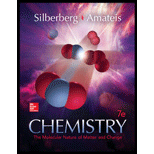
Concept explainers
(a)
Interpretation:
The formula and molecular mass of sodium dichromate are to be determined.
Concept introduction:
The molecular formula of a compound is a representation which suggests the total number of atoms of each element the compound is made of.
The molecular mass of a compound is defined as the sum of the atomic masses of all the atoms present in it.
The general formula to calculate the molecular mass of a compound is,
(a)
Answer to Problem 2.103P
The molecular formula for sodium dichromate is
Explanation of Solution
Dichromate is a polyatomic ion. The formula for the dichromate ion is
Hence the molecular formula for sodium dichromate becomes
The formula to calculate the molecular mass of
Substitute
The molecular formula for sodium dichromate is
(b)
Interpretation:
The formula and molecular mass of ammonium perchlorate are to be determined
Concept introduction:
The molecular formula of a compound is a representation which suggests the total number of atoms of each element the compound is made of.
The molecular mass of a compound is defined as the sum of the atomic masses of all the atoms present in it.
The general formula to calculate the molecular mass of a compound is,
(b)
Answer to Problem 2.103P
The molecular formula for ammonium perchlorate is
Explanation of Solution
Ammonium and perchlorate are polyatomic ions. The formula for the perchlorate ion is
Hence the molecular formula for ammonium perchlorate phosphate becomes
The formula to calculate the molecular mass of
Substitute
The molecular formula for ammonium perchlorate is
(c)
Interpretation:
The formula and molecular mass of magnesium nitrite trihydrate are to be determined
Concept introduction:
The molecular formula of a compound is a representation which suggests the total number of atoms of each element the compound is made of.
The molecular mass of a compound is defined as the sum of the atomic masses of all the atoms present in it.
The general formula to calculate the molecular mass of a compound is,
(c)
Answer to Problem 2.103P
The molecular formula for magnesium nitrite trihydrate is
Explanation of Solution
Nitrite is a polyatomic ion. The formula for the carbonate ion is
Magnesium belongs to the
While naming compounds containing polyatomic ions, when two or more of the same polyatomic ion are present, the ion appears in parentheses. The total number of the polyatomic ion is written as a subscript outside the parentheses.
In magnesium nitrite, two nitrite polyatomic ions associate with one magnesium ion. Hence the molecular formula becomes
Magnesium nitrite trihydrate is the hydrated form of the ionic compound magnesium nitrite. Upon hydration, the molecule of magnesium nitrite bonds with three molecules of water to form a trihydrate molecule. In the molecular formula, the water molecules are shown after a centred dot. Hence the formula for magnesium nitrite trihydrate becomes
The formula to calculate the molecular mass of
Substitute
The molecular formula for magnesium nitrite trihydrate is
Want to see more full solutions like this?
Chapter 2 Solutions
Student Study Guide for Silberberg Chemistry: The Molecular Nature of Matter and Change
- V Biological Macromolecules Drawing the Haworth projection of an aldose from its Fischer projection Draw a Haworth projection of a common cyclic form of this monosaccharide: H C=O HO H HO H H OH CH₂OH Explanation Check Click and drag to start drawing a structure. Xarrow_forwardComplete the mechanismarrow_forwardComplete the mechanismarrow_forward
- 8 00 6 = 10 10 Decide whether each of the molecules in the table below is stable, in the exact form in which it is drawn, at pH = 11. If you decide at least one molecule is not stable, then redraw one of the unstable molecules in its stable form below the table. (If more than unstable, you can pick any of them to redraw.) Check OH stable HO stable Ounstable unstable O OH stable unstable OH 80 F6 F5 stable Ounstable X Save For Later Sub 2025 McGraw Hill LLC. All Rights Reserved. Terms of Use | Privacy C ཀྭ་ A F7 매 F8 F9 4 F10arrow_forwardJust try completing it and it should be straightforward according to the professor and TAs.arrow_forwardThe grading is not on correctness, so if you can just get to the correct answers without perfectionism that would be great. They care about the steps and reasoning and that you did something. I asked for an extension, but was denied the extension.arrow_forward
 ChemistryChemistryISBN:9781305957404Author:Steven S. Zumdahl, Susan A. Zumdahl, Donald J. DeCostePublisher:Cengage Learning
ChemistryChemistryISBN:9781305957404Author:Steven S. Zumdahl, Susan A. Zumdahl, Donald J. DeCostePublisher:Cengage Learning ChemistryChemistryISBN:9781259911156Author:Raymond Chang Dr., Jason Overby ProfessorPublisher:McGraw-Hill Education
ChemistryChemistryISBN:9781259911156Author:Raymond Chang Dr., Jason Overby ProfessorPublisher:McGraw-Hill Education Principles of Instrumental AnalysisChemistryISBN:9781305577213Author:Douglas A. Skoog, F. James Holler, Stanley R. CrouchPublisher:Cengage Learning
Principles of Instrumental AnalysisChemistryISBN:9781305577213Author:Douglas A. Skoog, F. James Holler, Stanley R. CrouchPublisher:Cengage Learning Organic ChemistryChemistryISBN:9780078021558Author:Janice Gorzynski Smith Dr.Publisher:McGraw-Hill Education
Organic ChemistryChemistryISBN:9780078021558Author:Janice Gorzynski Smith Dr.Publisher:McGraw-Hill Education Chemistry: Principles and ReactionsChemistryISBN:9781305079373Author:William L. Masterton, Cecile N. HurleyPublisher:Cengage Learning
Chemistry: Principles and ReactionsChemistryISBN:9781305079373Author:William L. Masterton, Cecile N. HurleyPublisher:Cengage Learning Elementary Principles of Chemical Processes, Bind...ChemistryISBN:9781118431221Author:Richard M. Felder, Ronald W. Rousseau, Lisa G. BullardPublisher:WILEY
Elementary Principles of Chemical Processes, Bind...ChemistryISBN:9781118431221Author:Richard M. Felder, Ronald W. Rousseau, Lisa G. BullardPublisher:WILEY





